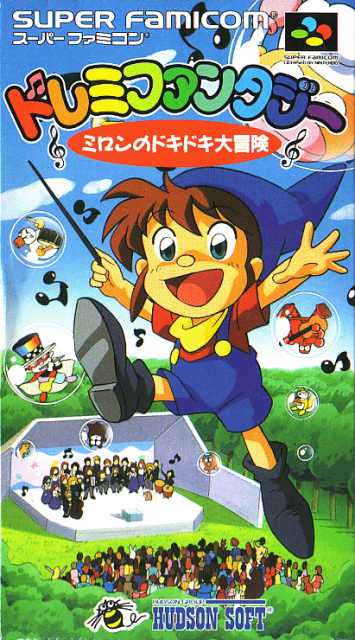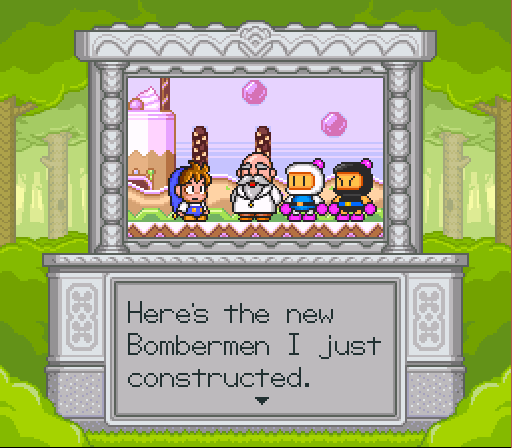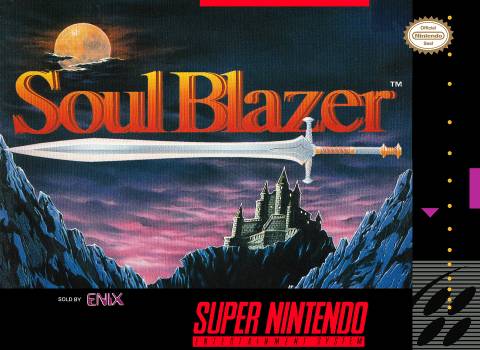The SNES Classic Mk. II: Episode XIV: Soul-fége
By Mento 0 Comments
The SNES Classic had a sterling assortment of games from Nintendo's 16-bit star console, but it's hardly all that system has to offer a modern audience. In each installment of this fortnightly feature, I judge two games for their suitability for a Classic successor based on four criteria, with the ultimate goal of assembling another collection of 25 SNES games that not only shine as brightly as those in the first SNES Classic, but have equally stood the test of time. The rules, list of games considered so far, and links to previous episodes can all be found at The SNES Classic Mk II Intro and Contents.
Episode XIV: Soul-fége
The Candidate: Hudson's DoReMi Fantasy: Milon no DokiDoki Adventure

Yeah, I'm back on my cute platformer bullshit. You know that thing where Kirby always looks mean and tough on all the North American and European box art of his games? I imagine that image problem is precisely why we never got half the adorable, pastel-tinted, low-key platformers that the Super Famicom saw in great quantities, like so many kittens tumbling out of a big sock. No matter, because that was remedied for this episode's Candidate game DoReMi Fantasy: Milon no DokiDoki Adventure from Hudson, which was one of a handful of Virtual Console games to be released globally despite being an untranslated Super Famicom exclusive.
If that kid in the dorky Keebler Elf hat looks familiar to you NES owners out there, this Milon is indeed the Milon of Milon's Secret Castle fame. Even though it's a direct sequel, DoReMi Fantasy is a little bit of a departure, with a more standard linear stage format and less of all the milling around confused for hours shooting bubbles everywhere to look for hidden items. Certain aspects have been retained for the sake of Milon's super strong brand: he still fires bubbles, which renders enemies incapacitated for a brief time Bubble Bobble style, and he can also jump on them to create temporary platforms. There are power-ups to collect, some that last until you lose a life and others that stick with you until you eventually game over. Milon's health system is represented by colored overalls: red for one hit, blue for two, and green for three. Getting hit drops you down a color, though there are usually (but not always) plenty of health boosts to be found across stages. At the end of each of the game's seven worlds is a boss (there's two in World 7), and these fights tend to be a little more taxing than you might expect, especially if you wander in without full health.
But those are the broad strokes. DoReMi Fantasy actually has some clever depth to its design that isn't immediately apparent; they're more like small quality-of-life decisions that you wouldn't expect to see in such an otherwise rudimentary 16-bit platformer. Decisions like having power-ups you don't need transfer into the game's coin equivalent that gives you an extra life upon reaching 100. If you have max lives, hitting 100 again will confer upon you a brief Star Man-style invincibility instead. Nothing is ever wasted, even if the item you just collected goes through several forms before you get anything out of it. Likewise, there's little touches like how Milon will freak out mid-air like Wile E. Coyote if he's about to drop down a large pit (regardless of whether or not there's something at the bottom), giving you a small window of opportunity to get him to terra firma. The one time the game let me down was in reaching a barrier that could only be destroyed with a charge-up attack; this was something the game never introduced, despite introducing every other world-specific hurdle early on (like climbable surfaces, and whether or not you should be on the lookout for false exits that reset the stage).

Graphically, the game looks fantastic. It has a certain cutesy style I previously mentioned, but Milon and the enemies are well-animated and there's some evident work put into the design of each world's aesthetic and the backgrounds and level geometry of individual stages. Musically, the game's a lot like Plok from last week: half of it is the peppy, upbeat music you'd expect from a mascot platformer game of its type, and the other half is this chilled ambience with the occasional rhythmic snippet that feels like an experimental jam sesh at the local jazz hut. You can listen to a couple of these BGM here and here; the game only has around a dozen stage tracks total, so you hear them all a lot, but these ones are definitely not of the norm. I looked up the composer, Jun Chikuma, and she's one of Hudson's most prolific musicians: she did a considerable number of Bomberman games, for instance. It's possible she maybe had a little more free rein to let loose here.
But now I'm starting to cannabalize my P.O.G.S. rundowns. Let's see what those judgemental little discs have to say this time:
- Preservation: While it does have some tight design and a really attractive 16-bit pixel style that looks about as hand-drawn as you can get anything to look on a 16-bit system (Yoshi's Island and Kirby's Dream Land 3 excepted), there's a certain "of its time" feeling to the game's sort of threadbare mechanics. I'm not suggesting it needs spacewhipper tech or RPG elements to feel modern, but while there's nothing much wrong with it there's a certain lack of depth that a newer platformer would endeavor to find. 3.
- Originality: DoReMi Fantasy has a disadvantage in this category simply for the reason that its predecessor, as flawed as it was, was a more novel take on a platformer. DoReMi feels safe in comparison; a game clearly riding the coattails of Super Mario World and other mascot platformers of that ilk, with its power-up system and sequential stage format that really only had a world map so you could revisit past stages for items you'd missed. All the same, if we're just comparing it to other SNES platformers, then it mix of ideas and abilities does flesh it out somewhat. It also does this curious thing where every last normal level of a world is a maze with unique (and usually creepy) enemies that feels like the game's take on SMW's Ghost Houses. 3.
- Gameplay: While I think the game is uniformly excellent, there are a few weird difficulty spikes here and there. Like, auto-scroller stages that don't have nearly as many health power-ups. Or how much harder the game becomes whenever you lose the glide boots, which had me tempted several times to keep track of where I last found a pair so I could quickly jump back into that level, grab them, and then leave (you definitely need to do this for health if a boss fight is coming up). The bosses, meanwhile, demand a lot from you: not just pattern recognition, but learning to get around their enormous hit boxes and take your hits where you can. I spent an awful long time on a sun and moon tag team boss (gee, I wonder where they got that idea) because their attacks were relentless and the window to hit them was so small and fleeting. Still, there's something to be said for platformers you couldn't beat in a day. 4.
- Style: Really, the animation and music are top-notch here. I wasn't expecting too much, especially of a Milon game, but it really surprised me with how sophisticated it felt. Some of that's due to the release date - March 1996, which is very late for the system, and well into the PS1/Saturn era - but I think Hudson were uncharacteristically devoted to this little elfin twerp after what I can only hope was a divisive reception to the original Milon's Secret Castle. Little touches like the animated champagne towers in the Food World or the way the chef boss is sketched in one line at a time like the intro to Kirby's Adventure (with this great fake Mario Paint track) - the game isn't lacking for dedication and effort. 5.
Total: 15.
Other Images:
The Nominee: Quintet's Soul Blazer

I realize this feature's been suspiciously Quintet-free, barring the appearance of ActRaiser all the way back in the very first episode. I am building towards the rest of the library of the developer I would consider to be the SNES's most consistent in terms of quality, but it's going to require a lot of putting into works just how profoundly these games affected me as Lil' Mento. Illusion of Time especially, which did so much to sell me on the immersive storytelling potential of a JRPG, and its even superior sequel Terranigma. Before we get started on those two, however, we should head back to where the Soul Blazer series started with, perhaps predictably, Soul Blazer.
Soul Blazer isn't afraid to start weird and get progressively more so. You don't get much preamble, instead showing up in a metaphysical dimension and getting commanded by a deity - perhaps ActRaiser's protagonist - to save the world by recovering it piece by piece from where they're trapped in the dungeons beneath the land. You then get a small tutorial on how the game works - simply murder creatures pouring out of an enemy spawner until the spawner runs out, and activate the now-exhausted spawner for a random surprise - before the game drops you in a grassy field with no landmarks except a cave entrance, and letting you explore from there.
Anyone in the know about Quintet's Soul Blazer series is that they have strong themes of environmentalism and rebirth. Each protagonist is invariably trying to restore the world to its former glory, taking on the agents of destruction that would rather leave it a barren lifeless wasteland, and through their actions slowly returning vigor to their surroundings. In Soul Blazer's case, the protagonist will activate extinguished monster spawners to suddenly rebuild a structure back in the featureless grassy field on the surface, or bring back a human, an animal, or a plant back to life. Some of these characters then help you in some way, offering a place to rest if you should run low on health or precipitating the next progression-vital step. Others simply relay hints or thank you profusely for bringing them back to life. What was once an empty field becomes a bustling village full of grateful faces. It's a powerful means of rewarding the player; not through stronger equipment, leveling up, or fantastic wealth - though you get plenty of all three through incidental means - but by witnessing the significant effect on the world and its populace that the player is enacting. That it would also be the basis of my favorite JRPG of all time - Level-5's Dark Cloud 2 for the PlayStation 2 - and my favorite Indie game of all time - Re-Logic's Terraria - is no accident: I really get a visceral sense of reward from actively aiding people and helping their world flourish, even if they're just mindless NPCs who have three or four lines of dialogue at most.

The gameplay of Soul Blazer isn't a slouch either. Though it's fairly basic to begin with, it's easy to get overwhelmed early if you rush in with your sword swinging. For one, enemies move fast and your range is pathetic, forcing you to respect distance to avoid getting surrounded. A little later, you resurrect a tool shop owner who will give you a free medicinal herb whenever you run out: these automatically heal you when you hit 0 HP, like The Legend of Zelda's fairies, and the game gets marginally easier from then on. The combat system would see a massive upgrade in Illusion of Gaia, and another in Terrangima, but even this early on in its evolution it has enough quirks and challenges as an action-RPG to keep you on your toes - it's also a refreshing departure from the system's many turn-based RPGs.
I could maintain this effusive encomium for another paragraph or five, but let's make it official by invoking our old friends the P.O.G.S. system:
- Preservation: Exceedingly well. Soul Blazer has a sharp, clean look that is helped by the amount of distance it maintains from the playable character and the field. It looks mildly like a 16-bit Gauntlet in practice - a game I'm sure was a major inspiration, given all the spawners - but the unique hook of having your rewards be (literal) surface-level cosmetics that you're nonetheless invested in finding really sets it apart from everything else on the system. That we still have dungeon-crawling RPGs coming out today that moonlight (so to speak) as town-building sims is a practice that owes no small debt to Soul Blazer. 4.
- Originality: Well, as was already stated, the game's big innovation was having the player restore the village that they would normally rest and recuperate at between dungeon runs. It's sort of like if Wizardry only allowed you to rest at the Inn after completing the first level of the dungeon and receiving the Inn as a reward. That idea is still in its inchoate stage here, but had evident potiential in spades - Dark Cloud would greatly expand on its scope, letting the player place and decorate new buildings and fixtures as well as complete landscaping puzzles. 5.
- Gameplay: Unlike its many spiritual successors, there is no "gameplay" part of its town-building quotient. That all happens automatically as rewards for defeating enemy spawners. The core game is simply destroying those spawners by taking down the enemies that come out of them - each of which usually has their own attack patterns to learn - and making forward progress. There's a certain recursiveness to the dungeon design - you're rarely expected to plow through the whole dungeon in one go, instead taking the time to head back to the village to recover and see what's new, before jumping back in close to where you left. It's solid but relatively straightforward hack n' slashing. 4.
- Style: The game's look does have a certain staidness about it, due to the way it zooms out and makes characters look indistinct. The spritework is uniformly great though, especially with the monsters, even if some of the dungeon design can be a little uninspired. I'd say graphically we're still approximately in ActRaiser town - Quintet's trademark font is still here, which the internet dubbed "Lunchtime Doubly So" after a Douglas Adams reference - but unfortunately lacks that game's large and detailed sprites for its action stages. Musically it's just sort of whatever; its sequels will be a lot more impressive in that department. A little plain all around, but maybe that just helps the great concept at its center stand out all the more. 3.
Total: 16.
Other Images:











